|
Congratulations! If you're snooping around in the fishing report archives,
you are one of those dedicated anglers who spends the extra time it takes to
become an expert at your craft!
I
respect folks who do their homework and that's why I have these reports
archived. You can glean a lot of information about seasonal trends and movements
of the fish in the Northern Minnesota, 1000 Grand Lakes Area. The archives are
organized by quarters; 1- (January, February, March) 2- (April,
May, June) 3- (July, August, September), 4- (October, November,
December). When you study the fishing patterns and fish movements through these
seasons, you might just see some interesting trends that will help you organize
your strategy for your next fishing trip.
I hope you find plenty here that
will help and if you think it does you some good, let me know. I'd appreciate
questions and comments that will in turn help me provide more meaningful reports
for everyone. If you have a question
Click Here.
|
July 2006
|
Another Hot Week, More Hot Bass and Panfish Action -
Jeff Sundin |
|
What a week! The heat keeps on coming and surface water temperatures
in the Itasca area are firmly established in the upper 70’s and even
into the low 80 degree range on a few of the darker water lakes. Even
though the heat has worked to slow down the Walleye action in many of
the area’s better lakes, fishing opportunities for Smallmouth Bass,
Largemouth Bass, Panfish and Muskies is probably as good as it can
get!
Bluegill lakes all around the Grand Rapids area continue to produce
both quantity and quality fish. I expect that as long as the water
temperatures remain warm and the weather stays relatively stable,
these scrappy fish will continue to bite. We’ve had a great time with
them this week and discovered that every lake has had a little
different twist when it comes to choosing the best baits and
presentations. On a few of the lakes where both Bluegills and Walleye
are present, my favorite approach has been to use live bait rigs
tipped with large Leeches on the deeper weed edges. The larger leeches
are attractive to the best Sunfish and it’s really helped to cut down
on the little fish. Keep on rigging those weed edges and it’s just a
matter of time before you’ll find a school of Walleyes to keep the
trip interesting.
Bluegill lakes that don’t have great deep water weed edges force us to
get up into the heavier weed cover. Then I switch the fishing style
over to a small 1/16-ounce jig head tipped with a cut piece of night
crawler, small worm or leech. There’s a little searching to do before
we find the better schools of ‘Gills, but if we move slowly through
the weed beds and fish vertically, we’ll find pockets or clear spots
in the weeds. These small harder bottom areas have been the best spots
for better schools of fish and it’s been well worth the search. More
than once this week, we’ve been able to locate fish using the live
bait and then switch to small plastic baits. My favorites this week
has been a small plastic crawfish and tiny 2-inch plastic worm fished
on a 1/16-ounce jig head.
Bass fishing for both Largemouth and Smallmouth can’t get any better
than it’s been. With the warm water, the Largemouth Bass seem to have
gone on a full time feeding frenzy and if I’ve ever seen better
action, I can’t remember when it happened. The deep weed patterns are
always my favorite and that’s been the key to success throughout the
last month. I always like a six inch plastic worm fished on a jig
head, this summer I’ve come up with a new twist on the jig heads that
really works great. The lightweight "slow fall" jigs (by Jigs ‘n ‘
Rigs) are Non Toxic and weigh about half of what the standard lead
heads used to weigh. So now you can fish a larger hook and bulkier
profile bait without plowing to the bottom. My favorite has been a
six-inch Lizard on a "slow fall" jig with a 1/0 hook. The Bass are
really tearing up that combination.
Smallmouth Bass have been just as active, but deeper points containing
rock, gravel or clam beds have been better producers. Fishing deeper
structure has been better with live bait rigs tipped with Jumbo
Leeches or lively minnows leading the way. A six-inch Creek Chubb or
even an extra large Golden Shiner on a live bait rig really gets their
attention. Try not to feed line, just let them snuggle up a bit and
then set the hook. Waiting too long will result in fish swallowing the
bait. Then you run the risk of damaging the fish before you can
release it. Early and late in the day, Smallmouth can be caught too by
casting a jig worm combination up onto the shallow flats adjacent to
these deeper points. Work the bait down the drop with a twitching
motion and hold on to the rod!
The better Walleye fishing action has become centered around Weedline
and shallow structure on a lot of the area’s better known lakes. But
there are some exceptions and one tip I’ll pass along is to look for
opportunities on some of the deep water, clear lakes that have decent
Walleye populations. You know the ones, lakes with a reputation for
being "night lakes" or known as tough to fish. At a time when the best
Walleye lakes have been fished hard, there are several lakes that
receive much less pressure and don’t really turn on until the water
gets warm. You might have to stay out and fish the evening bite on
these clear water lakes, but the best fishing of the season is
happening now while the water temperatures are keep those fish active.
Deeper points and main lake humps in the 20 to 40 foot ranges are the
best daytime or early evening locations. You’ll find that it’s fairly
easy to see fish on your electronics, rigging with leeches or vertical
jigging has been the best way to go. I’ve tried rigging with crawlers,
but between the Sunfish and small Perch, it’s awful hard to keep a
crawler intact long enough to attract a Walleye.
On the more traditional Walleye lakes in the area, there are enough
fish going on the "crankbait bite" to make it worth taking a look at.
Fish the outside edges of the weedline with a number 5 Shad Rap, Husky
Jerk or RattleTrap. I like to keep my speed around 2.5 MPH or so.
Sometimes a bit faster or slower, depending on the depth and weed
cover. Fishing the same weedlines with live bait rigs and spinners
will also produce some fish right now, particularly if you get a
decent drifting wind.
Perch fishing has greatly improved especially on Big Winnie and we’ve
had some great catches of the true mid summer jumbos and even magnums
this week. It’s been slow to come this year, but the deeper fish are
showing up on not only the mid depth flats, but on the lakes deeper
bars and humps. At times we’ve had to work an area fairly hard to get
them started, with the first few fish coming in slow and sluggish. But
once we get the ball rolling, the bite keeps picking up as fish in the
area jump on the bandwagon. It’s been fun to watch the screen on my
Lowrance fill up with fish as they gather around some of these deeper
humps. I really like a simple jig head tipped with a minnow for
catching these fish. Once you get a school started, fish vertically
hovering about the fish or just barely moving around them. Usually
you’ll get an hour or so on the better spots. If the bite fizzles out,
move on to greener pastures.
With early signs of a summer fish kill looming, Tulibees, Suckers and
other cool water fish have moved onto the shallower mid depth flats.
Larger Pike and Musky have started following their preferred baitfish
into the shallows and action has started picking up. Reports of
several Muskies caught this week on Winnie and Cutfoot Sioux tend to
make me think that we’re on the verge of my next happy time of summer,
where casting for Pike and Muskies leads us into the fall bite. |
|
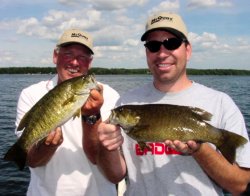

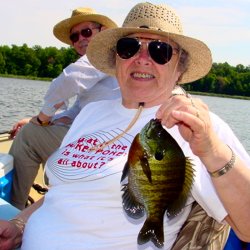
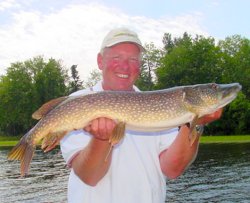


Click Here For Fishing Report Archives
|
|
Fishing Report 7-20-06 Hot Bluegill Action Right
Now! - Jeff Sundin |
|
Grand Rapids, Deer River and the Itasca area have been blessed with
several days of great summer weather and the fishing for Bluegills,
Perch and Bass has really heated up. After a heat wave last weekend
that threatened to make wimps out of even the toughest anglers in the
region, a cool down delivered relief from the heat and sparked an
enthusiastic response from the fish. For folks like me who enjoy the
"action bite", this is prime time to load up the family and get out on
the lakes while the weather is perfect. The water temperatures are at
or near the highest they will ever reach for the season. Some area
lakes have surface temperatures well above 80 right now and even the
coolest waters are consistently showing temps in the mid to high 70
degree range.
Bluegills have been the highlight of the week as they are on what I’d
call a ravenous bite right now. These scrappy fish seem to be
everywhere and I’ve seen lots of good quality size fish in the past
several days. The size of the fish varies from lake to lake, so your
own research and experience is going to dictate where you look for
them. But, on virtually every lake I’ve been on, the pattern is the
same. Look for the same structures you would fish for Walleyes like
deep weedlines points, gravel/rock bars and sunken islands with weed
cover on top. This has led to many mixed bag catches that included
Walleye, Bluegills and Bass all on the same structures. The fish have
been most active on the deepest edges of the cover, so we’ve caught
many of them on live bait rigs tipped with leeches while we’ve been
fishing for Walleyes. The larger the leeches, the larger the bluegills
so stop at the bait shop and get a good supply. Once we’ve located a
school of better fish, we’ve switched over to a 1/16-ounce jig and a
small cut piece of worm or night crawler. This speeds up the action
and reduces the number of fish injuries from deep hooking. I don’t
know how long this bite is going to last, but you owe it to yourself
to pack up the kids and get out there this weekend.
Walleye fishing is in the classic mid summer pattern right now.
They’re biting really well at times, but with huge supplies of
baitfish, insect larvae and other treats, the fishing has its ups and
downs. One thing I’ve noticed this week is that the fish are in a
slightly different location every day. I’ve had to coach myself to
keep looking in new areas and I’ve had to forget about some of the
"good spots I fished yesterday". I really think that there’s enough
food in the lakes right now to keep the Walleyes satisfied 24 hours a
day, so the best bet is to keep searching until you find yourself in
the midst of a school that happens to be feeding now. You’ll find lots
of fish on your Lowrance, but if you can’t get the walleyes in that
school to bite, move on to another spot. It might seem like a lot of
work, but there is almost always a place where you can get them going
if you keep after them.
Once you find the Walleyes, the best baits are still Leeches and Night
Crawlers fished on either a live bait rig with a five to six foot
leader. Adding a spinner to the live bait rig is simple and it seems
to be just the ticket at times when you find active fish. One thing to
remember at this time of year, is that the warm water can really get
the fish moving and it’s possible to miss fishing opportunities by
moving too slowly and using an aggressive approach like spinners or
crankbaits moved quickly through a school of fish can sometimes
trigger more hits than using the classic slow presentations we rely on
most of the season.
Weedline Bass action is at its best right now and like the Bluegill
fishing, warm water has triggered a hot bite. We’ve had good action on
a variety of soft plastic baits. A couple of great producers have been
soft plastic Crawfish imitators and standard six-inch plastic worms.
The fish have been plenty aggressive so the jig head with an exposed
hook is perfect. Cast toward the weed edges, let the bait fall, give
it a twitch or two and hold on!
Perch fishing is finally getting into high gear and fish that have
been absent for the past six weeks are showing up in good numbers on
rocky/gravel flats, rock humps and on deeper open water humps and
bars. There are an ample supply of keepers and even a few borderline
"magnums" to sweeten the pot. We’ve caught quite a few Perch on
Leeches while we’ve fished for Walleyes, but switching over to a jig
and minnow combination has been a better way to catch numbers of fish.
There are enough reliable spots holding Perch now that the search for
a good school won’t take long.
Larger Northern Pike continue to use open water, but there are some
early signs of movement back into the shallows. With increased Algae
blooms, higher water temperatures and depleted Oxygen levels in main
lake areas, habitat in the shallows starts slowly filling up. First
the baitfish arrive, then the Pike and Musky. There are already some
average size Northern Pike using the deeper and/or heavier weed edges
and I’d expect to see the numbers increasing during the next week or
two. For now, fishing these weedlines with deeper running baits is
your best bet. Jigs rigged up with a short piece of heavy mono leader
are good and so are live bait rigs using a 1/0 hook tipped with a six
to eight in Creek Chubb, Sucker or Redtail. In some of the better weed
patches, anchoring and using a slip bobber, 1/0 hook and large minnow
is also a good idea. Soon, we’ll be into the casting season and big
baits will work even better. But for now, stick with the live bait
approach. |
|
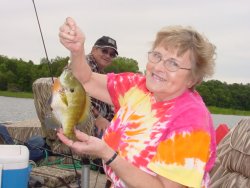
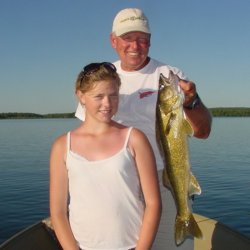

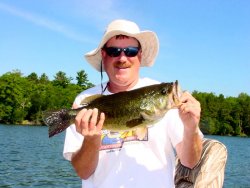


|
|
Fishing Report 7/11/06 Mid Summer Weed Patterns Are
Reliable - Jeff Sundin |
|
Northern Minnesota summer weather patterns are squarely established
with surface temperatures now ranging from 73 degrees¦
to 76 degrees¦ . During this mid summer,
warm water period, it’s common for our better Walleye fishing lakes to
have a variety of patterns going on at the same time. It’s
particularly true this year because our relatively warm and stable
conditions have created perfect conditions for hatching insects and
producing abundant young of the year minnow and game fish hatches.
With all of this "food" in our area lakes, Walleyes, Perch and Panfish
are finding it easy to chow down. To get in on the best summer
fishing, we have to adjust our fishing style to the conditions and
look for smaller groups of active fish, move frequently and use a
variety of styles.
Walleye fishing remains fairly good out on mid lake bars and humps,
but on several of the area’s better known Walleye lakes, these fish
have been heavily pursued by anglers. For the better part of a month
now there have been folks fishing on the best spots and the fish have
"wised up" to a lot of our tricks. Even though these mid lake bars,
reefs and sunken islands will continue to produce fish, your timing
will have to be good when it comes to being at the right spot at the
right time. Make frequent moves and keep a sharp eye on your
electronics. We’ve had a lot of instances where we find a group of
fish, catch a few of them and then "spook" the school. Once the action
slows down on a spot, I think it’s best to fire up the engine and move
on to another one. Occasionally, we’ll locate a better group of fish
that allows us to work a spot for a bit longer and we take advantage
of that opportunity, but always be ready to move at the first sign of
a slow down.
A more reliable Walleye pattern right now has been to fish the shallow
water weedline. With lots of good green weeds and an excellent supply
of baitfish, these weedbeds are holding decent numbers of fish and the
bite has been fairly predictable for the past week or so. We’ve had
our best luck fishing with Leeches and Night Crawlers. There have been
a few fish caught on jig and minnow as well, but I’d classify that
option as more of a mixed bag approach. If you’re interested in
catching a bit of everything, the jig/minnow approach could be good.
But if it’s Walleye or bust, go with the leeches and yard bait. Fish
as far into the weedline as you can get away with. If you have sparse
weeds with lots of open spots and holes, don’t be afraid to go right
into the cover with your boat and fish slowly with your MinnKota. If
the weeds are too heavy for that approach, fish as near the edge as
possible and try to keep your baits within easy reach of the outside
(or inside) edges of the weed growth. Water depth will vary from lake
to lake because water clarity and bottom content will produce weeds at
differing depths from one lake to the next. The best rule of thumb is
to move your boat shallow until you find the heavier cover and then
back out to edges. Once you find the depth where the weed edges occur,
it’s likely to be fairly uniform everywhere on your lake.
Weedline action has also been improving for the Bass and panfish that
we love to catch during mid summer. We’ve had some excellent mixed bag
fishing on the deeper weed edges, especially where we can find rocks
mixed with or adjacent to the weedline. Some of this rock/weed mixed
structure will be holding 5 or 6 species of fish at the same time. On
a recent trip we caught Smallmouth, Walleye, Pike, Largemouth,
Crappie, Bluegill and Rock Bass all on the same spot. I really like to
start fishing these areas with a jig and plastic worm. A simple
1/8-ounce jig and a black or purple 6-inch plastic worm will work
great as a starter or "search bait". Once you figure out what kind of
fish a weedline is holding you can refine your presentation to better
suit the fish you locate. If you continue to catch Bass, stick with
the soft plastics and experiment until you find ones you really like.
If you find Crappies, you might want to switch to smaller jig/minnow
or jig/soft plastic baits, Walleyes? Try fishing smaller jigs with
night crawlers or leeches. You get the idea, match your bait to the
fish and cash in on whatever opportunity presents itself.
Perch fishing for me this summer has been hit or miss, with a lot more
misses than hits. Even though there have been some fairly reliable
spots on a small number of lakes, there is no real widespread action
bite that I can report on. The best approach I can find is to fish the
secondary drop off areas where shoreline flats meet with the deeper
water of the main lake. In other words not the shallow drop off areas
that you’d find in 5 to 8 feet, but the areas where water drops from
12 to 18, maybe a bit shallower or deeper depending on the lake you’re
fishing. Cruising along this secondary drop off area with a
spinner/minnow combination is a good way to find the Perch. When you
find a better school, they will frequently be on a small patch of
gravel or rock located on these flats. You can slow down and fish
these areas with jig/minnow combinations as well.
Larger Northern Pike continue to use open water where cooler
temperatures and larger baitfish roam at or just above the lake’s
thermocline. On several of the area lakes we’ve been able to recognize
this thermocline setting up at 22 to 26 feet deep and when you watch
your Lowrance, you can actually see the line where deeper cold water
meets with the warmer surface water and creates a "barrier" called a
thermocline. Most baitfish and game fish will hold at or just above
this barrier and these fish are what you see represented on your
Lowrance. Not all of the Grand Rapids area lakes have a thermocline,
but when you find the ones that do, you can troll deeper diving
crankbaits over open water to catch some of these larger Pike. Walleye
and Musky if they’re present in your lake can also be caught with this
open water trolling approach. A deep diving bait like the Salmo Perch
or Deep Diving Shad Rap could be all you need. But if you find fish
deeper than 20 feet, you’ll probably need to add some weight. The
simplest way to do this is by adding a snap weight, bell sinker or
even the rubber core type sinkers to your line a few feet ahead of the
crankbait. Experiment with weights and keep track of how much line you
let out by counting how many rod lengths of line you have out. If you
start getting serious about the deep trolling, you can buy reels that
keep track of the line with a counter. But for starting out, counting
the rod lengths will get you in the ballpark.
We’ve had some decent Crappie fishing this week and I’m optimistic
about the prospects for the next week or two as well. Heavy cover is
the secret during the day. On one Deer River area lake we found a nice
school of Crappies using a heavy patch of coontail weeds mixed in a
larger patch of Cabbage weeds for cover. On another, we’ve found them
among brush piles. In either case, we’ve had to fish vertically (up
and down) from an almost stationary position to catch them. If you’re
fighting the wind, moving too fast or fishing too far above them, they
will let you pass right on through without striking. Hold the boat
still and get the bait in their face, then you’ll start catching some.
For faster action, fish these areas at twilight with a slip bobber.
Crappies are notorious for that "evening run" along and above the deep
weeds.
Bluegills aren’t too far from the same type of structures and to help
catch more of them, switch to a jig with a cut piece of worm as bait.
Fish closer to the bottom along the weed line and the Bluegills are
active enough to find you. Once you locate a school, try moving in
(shallower) and out until you fine-tune the location. Then stay close
to that area and fish it thoroughly. |
|



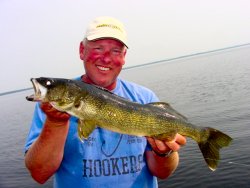
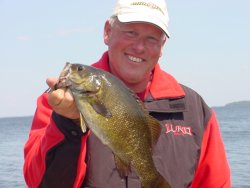


|
June 2006
|
Fishing Report –
Jeff Sundin |
|
A warming trend is gently pushing up surface temperatures and moving
the summer feeding patterns into full swing. On Wednesday the surface
temperature on Lake Winnibigosh was 73 degrees at mid day. Most of the
Deer River and Grand Rapids area lakes are in that temperature range
right now. Mayfly hatches that were heavy last week have noticeably
declined in the past day or two and a shift from "Walleye or die"
fishing to the mid summer mixed bag style fishing is slowly taking
shape for me. Continued warming predicted for the next week should
continue to push us in that direction. I wouldn’t be surprised to see
excellent mixed bag opportunities developing.
Perch that have been weed bound and illusive for the past few weeks
are inching their way toward the open water structures that they use
during mid summer. The softer bottom areas surrounding mid lake humps
and bars have attracted some nice size Perch. Although they are in
small numbers so far, the trend is moving us toward some good open
water Perch fishing. Checking the smaller rock areas and deeper weeds,
we’ve discovered that some Perch are moving toward areas where
Crawfish are most abundant. Mixed sand and gravel with light weed
cover are perfect locations and it looks like we’ll be into some
action on those spots as well during the next week or two.
Click here
for more about mid summer Perch fishing on Lake Winnie.
Walleye fishing in the area is what I’d call "good" providing you’re
adaptable and willing to work at it. They’re certainly not on an all
out rampage, but sticking with the search and adapting to conditions
as they develop will keep you in enough fish to make it interesting.
Unchanged from last week, we’re still fishing mid lake humps and bars.
The ratio of "keeper size" versus "slot size" fish has shifted
noticeably toward the smaller keepers. We’re still releasing a larger
portion of the "slot fish" but finding keepers has become easier this
week.
Walleyes inhabiting the weedlines are generally running smaller than
the mid lake fish, but with minnow populations at seasonal highs,
these fish are well fed too and it takes some searching to find a
hungry school of fish. On the bright side, if you keep looking, you
will find them and when you do they are more susceptible to jig and
minnow or jig and worm style fishing that usually leads to some of the
greatest Minnesota mixed bag fishing of the year. This is some of my
favorite fishing because you can catch a variety of fish on the same
baits, on the same weedline, on the same trip.
Larger Northern Pike are in open water where cooler temperatures and a
new supply of baitfish, mainly Tulibee are providing some excellent
feeding opportunities for them. If you’re after some better than
average Pike, tolling deeper running crankbaits like the Salmo Perch
or deep running Shad Raps will get you into some action. Another good
approach, try running a live bait rig with a 17 to 20 pound test
monofilament leader, 2/0 hook and a seven to 10 inch minnow along the
edges of main lake structure. Steeper edges along the breakline, areas
with scattered rock and areas near weed flats are good places to start
looking. Fish the rig just like you would use a Lindy Rig for Walleye.
Substituting the larger minnows will help attract a higher percentage
of Pike, but don’t be surprised if you catch a few nice Walleyes while
you’re experimenting.
We’ve had some decent Crappie fishing this week and I’m optimistic
about the prospects for the next week or two as well. Heavy cover is
the secret during the day. On one Deer River area lake we found a nice
school of Crappies using a heavy patch of Coontail weeds mixed in a
larger patch of Cabbage weeds for cover. On another, we’ve found them
among brush piles. In either case, we’ve had to fish vertically (up
and down) from an almost stationary position to catch them. If you’re
fighting the wind, moving too fast or fishing too far above them, they
will let you pass right on through without striking. Hold the boat
still and get the bait in their face, then you’ll start catching some.
For faster action, fish these areas at twilight with a slip bobber.
Crappies are notorious for that "evening run" along and above the deep
weeds.
Bluegills aren’t too far from the same type of structures and to help
catch more of them, switch to a jig with a cut piece of worm as bait.
Fish closer to the bottom along the weed line and the Bluegills are
active enough to find you. Once you locate a school, try moving in
(shallower) and out until you fine-tune the location. Then stay close
to that area and fish it thoroughly. |
|
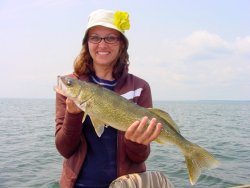
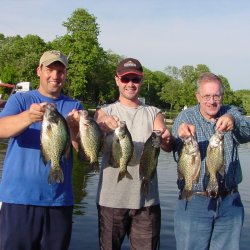



|
|
Fishing Report 6-22-06 Summer Walleye Strategies –
Jeff Sundin |
|
The summer solstice has arrived and the classic mid summer Walleye
fishing patterns are in full play right now. Cooler weather and lots
of windy days have brought surface temperatures back down into the
high sixty to low seventy degree range and a re-birth of the weedline
bite has really charged up the action on a handful of the Grand Rapids
area lakes.
Most Walleye fishermen in the area (including me) have really focused
on the deeper, main lake structures for the past couple of weeks and
those deeper structures are still producing very well. In fact, if
you’re trophy hunting and enjoy the classic deep structure fishing
with live bait rigs, I’d suggest sticking with that pattern for a
while. If you like the "action bite" and prefer shallow jigging the
weedline, the wind and cooler weather have brewed up a pretty darn
good shallow fish opportunity. We’ve found that the best action
centers around loosely grouped cabbage weeds on shallower flats. Six
to eight feet of water has been a key depth range. I’ve had to work to
locate any areas where the weeds are mixed with either gravel or light
rock/sand and when I find this type of structure, we’ve found smaller
Walleye (eater size) of 13 to 15 inches in larger numbers. Depending
on what else is available in the lake, we’ve also found plenty of
Northern Pike, Bass and panfish in these same weedlines.
Two presentations have produced best. First, a 1/16 ounce "Sneaky
Pete" fished with a smaller size Rainbow Chubb and second, a live bait
"Lindy Rig" substituting a 1/16 to 1/8 ounce bullet sinker for the
traditional slip weight. Leeches or crawlers can be used on the live
bait rigs, but I think crawlers are currently out performing leeches
on the lakes I’ve fished. This live bait rig fishes the weeds fairly
well especially when the fish are willing to roam out to the edges.
Move slowly along the weed edges with your electric trolling motor and
work the jigs by casting up into the weeds, then working slowly back
toward the boat. The rigs can be fished just outside the deeper edges.
When you find a school of fish, re-run the area once or maybe twice,
then move on to find "new" fish.
Largemouth Bass, Crappie and Bluegills have begun to show up in these
deeper patches of Cabbage and in some of the Coontail patches along
the outer edges. We’ve literally stumbled on to these fish while we
work the weed edges for Walleye, so if you’re flexible, you can get
into some of the mid-summer mixed bag fishing right now. If we find a
school of Bass on these outer edges, switching to a 1/8-ounce jig and
plastic worm combo produces great action. Bluegill nip at the tail of
the plastics and you can zero in on them by switching to a small jig
and cut piece of worm. If you hit a school of Crappies, try the same
small jig, but substitute a 1-1/2 inch tube or small twister tail.
Cast these into the weeds and fish them with a slow pumping action.
If you fish lakes with brush piles, cribs or other heavy Crappie
structure, you’ll be able to find some fish in these locations as
well. Another early summer pattern that most folks can master easily
is to anchor along the deeper weed edges during the evening and fish
with slip bobbers until dark. The panfish go on a feeding binge at
this time and small jigs tipped with minnows (for Crappies) or a cut
piece of worm (for Sunfish) will get you in on some good action.
Larger Northern Pike have mainly moved out deeper. But this same
shallow weed structure will produce some fish of decent "eating size"
along with lots of smaller Pike, particularly on the jig and minnow
combo. For more information,
click this link to a recent article about
Pike fishing that sheds some light on utilizing these smaller Pike for
eating.
Perch
fishing can be good at times, but there are a lot of days when the
Perch seem to have vanished. My best guess is that the super abundant
baitfish supply is keeping the Perch well fed, satisfied and
scattered. Only when you find an active school, will they really bite
well and since they’ve been scattered, we’ve had to struggle to keep
locating small groups of fish. |
|
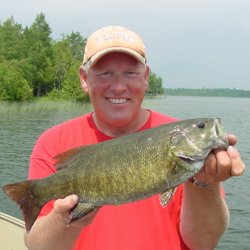
Bass, like this Smallmouth are locating
on the deeper points and weed edges. This fish hit a jig & Crawler during
the search for Walleyes. Nice bonus!
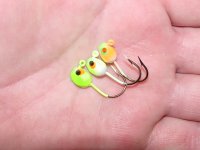
Small jigs like these 1/16 ounce Sneaky
Pete's are great for fishing the weeds. Short hooks and streamlined body
make them less prone to snagging.

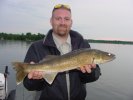


|
|
Fishing Report 6-14-06 Summer Peak Fishing Period
Arrives – Jeff Sundin |
|
June fishing trips are in high demand in Northern Minnesota and it’s
shaping up to be just the kind of weather for fishing that most folks
hope for. Mid seventy to lower eighty-degree air temperatures,
combined with stable weather and ideal water temperatures have made
this a very nice week of fishing.
For anglers that are Walleye fishing in the Grand Rapids region, the
pursuit has become more centered on deep fish that have moved out to
main lake structures. Walleyes of every size are showing up in larger
numbers each day to take advantage of the insect hatches, minnows and
larger baitfish. Tulibees, Suckers and Whitefish will all attract
larger fish while young perch, shiners and other minnows attract the
smaller ones. This has been good news for those folks fishing lakes
with protected slot size limits, because for a time, only the larger
fish were present on main lake humps, reefs and bars. Now these
structures have a reasonable number of keeper size fish along with an
opportunity to catch a very nice "picture fish" or maybe even a
trophy.
Live bait rigging has become more important every day and even though
we can still catch some nice fish on a jig and minnow combination, the
rigs tipped with either night crawlers or leeches are the best
performers. Rig length? For fishing lakes like Winnibigosh, Bowstring,
Sand and others in our area, I like rigs that are 5 to 6 feet in
length and tied on 6-pound monofilament line. I like colored hooks,
but I have had plenty of great fishing with the plain hooks as well
and I think it’s fun to experiment until you find a combination that
gives you confidence. So, try ‘em all until you get the color, length
and performance that you believe in. That’s what really makes it work,
mind over matter. A tip about the size of Leeches for Walleye fishing
has been that the "Super Magnum Jumbo Leeches" are working fairly well
for larger fish. But if you’re looking for an average size "keeper
Walleye", large or even some of the better medium leeches will get you
more bites and a higher percentage of eaters.
Crappie and Bluegills have begun to show up in the deeper patches of
Cabbage, Coontail and along the pouter edges of the deeper Bulrush
patches. Most of the spawning fish have wrapped it up for this summer
and are staged out in these deeper locations. If you fish lakes with
brush piles, cribs or other heavy Crappie structure, you’ll be able to
find some fish in these locations as well. One early summer pattern
that most folks can master easily is to anchor along the deeper weed
edges during the evening and fish with slip bobbers until dark. The
panfish go on a feeding binge at this time and small jigs tipped with
minnows (for Crappies) or a cut piece of worm (for Sunfish) will get
you in on some good action.
Northern Pike have moved toward deeper structure as well and the
larger fish are using structure with handy access to their preferred
food choices. Lakes with good Tulibee populations will generally have
better size Pike locating on steep drop off edges. Pike will also eat
Crappies, Suckers, Whitefish and even other smaller Pike. So any
structures with good weed or rock cover that’s located near deeper
water will produce some fish. If you like to troll, try using the
deeper diving crankbaits along the edges of main lake bars.
Bass fishing in shallow cover like Bulrushes is still good. Smallmouth
are moving along sandy breaklines and rocky areas in water depths of 5
to 8 feet. Some of the surface baits are still producing well, but if
you’re like me and like to fish with jigs and small plastic baits like
crawfish, twisters and plastic worms, your time is here to get active.
Perch fishing on Big Winnie has been a little tough for the past
couple of weeks. The good news is that they’re starting to show up a
bit more each day. Better numbers and better size fish are being
located in weeds located on the shallower flats. Concentrate on depths
of 5 to 8 feet of water and when you locate weeds that have rocks or
gravel mixed in, hover in that area and fish vertically and slowly.
For some reason, Perch have been more active on calm days so when you
see the lake turn to glass, head to the flats. |
|
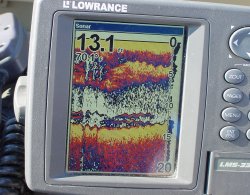
Walleye like the ones shown in the
picture above are cashing in one of the better feeding opportunities. A
huge school of Shiner minnows hovering within eyesight just under the
surface. In clear water, you can watch the minnows and occasionally even
spot the Walleyes as the roam the weed edges.
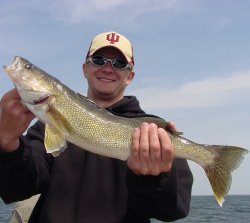
You can compete with all of that bait,
but you have to keep searching for an active school of fish. Trying a
variety of baits and locations will eventually pay off.


|
|
Fishing Report 6-8-06 Summer Storms Cause Momentary
Setback, Recovery Improves Walleye Fishing on Northern Minnesota
Lakes. - Jeff Sundin |
|
Summer storms like the one that pounded hard on most of Northern
Minnesota last Monday are usually to blame for a slow down in fishing
and this was no exception. A day after the storm past, we were trying
hard to locate active fish to keep the pace active. But this time the
effect of the storm passing through was less dramatic than usual. I
think it’s because it helped to counter-act the unusually hot weather
and warm water temperatures that we’ve had so far. On Monday, I was
able to find afternoon surface water temperatures of over 75 degrees.
On Tuesday the surface temperatures were back down below 70 degrees
and after a sluggish morning, the fishing had already begun to return
to a normal pace for this time of year.
Walleye fishing has probably been most affected by the enormous
populations of baitfish in area lakes. Bumper crops of baitfish such
as young Perch, Shiners and other minnows have made feeding easy for
hungry Walleyes. Add to that the increasing number of areas where
Mayflies and other insects are beginning to hatch and the result has
been feast or famine fishing for many folks. The fish literally have
it so easy right now that they don’t have to move to locate all the
food they need. If your timing is off, or if you give up the search
before you find an active school, some lakes could seem like the Dead
Sea.
The good news for Walleye fisherman is that if you find the right
school of fish at the right time, the Walleyes are actually aggressive
and easy to catch. In addition, there are a variety of approaches that
will produce fish right now and it’s likely that your favorite methods
will produce at least enough to keep you busy at times when fish are
active. During the past couple of days, jig and minnow combinations,
live bait rigs with night crawlers or leeches, spinner rigs,
crankbaits and slip bobbers are all producing fish. The secret has
been finding fish and then experimenting until you break the code of
catching fish from that particular school of fish.
Crappie and Bluegills are in the shallows right now and are in full
spawning mode as the warmer water draws them in. Look for fish in
water depths of 6 inches to about 4 feet, maybe a little deeper.
Panfish are actively building beds right now and slowly moving along
shoreline looking for the small "scooped out" areas will reveal where
the fish have been active. If you have problems locating the fish
during daylight hours, come back at evening and try these areas as the
sun goes down. Presentation is a small jig 1/16 or 1/32 ounce, help up
with a small bobber. Tip the jig with minnows for Crappie and use a
cut piece of worm for bluegills. If you have ultra light equipment,
you can cast small tubes, twister tails or feathered jigs without live
bait. This more aggressive approach is perfect for locating fish while
you are moving along a shoreline and want to check for signs of
activity in the area.
Northern Pike continue to inhabit the shallow weedline areas and the
small hammer handle size fish are so active right now, that it’s hard
to get your bait down to other fish in the area. Larger Pike are
showing up in the deeper water along sharp drops, rock bars and on
deeper weed flats. If I had to pick one presentation that would be
most useful right now, I’d go with live bait rigs, a 2/0 hook and
larger minnows like a Sucker, Creek Chubb or Redtail. Troll the baits
along steep breaklines to 14 to 22 feet of water.
Bass
fishing is still largely centered on the shallow water spawning beds
and most Bass fisherman are using spinnerbaits, jerk worms like the
Sluggo or small minnow type stick baits like the Salmo or Rapala.
Sight fishing around shallow bulrushes, mixed rocks and gravel or even
around boat docks is working well. For the time being, Smallmouth will
be found in the rockier sections of shoreline, Largemouth tend to
favor the weedier sections. Areas that contain both types of shallow
cover will produce a mixed bag including some panfish. |
|

Walleye like the ones shown in the
picture above are cashing in one of the better feeding opportunities. A
huge school of Shiner minnows hovering within eyesight just under the
surface. In clear water, you can watch the minnows and occasionally even
spot the Walleyes as the roam the weed edges.

You can compete with all of that bait,
but you have to keep searching for an active school of fish. Trying a
variety of baits and locations will eventually pay off.


|
May 2006
|
Fishing Report 5-29-06 Memorial Day Scorcher
Challenges Walleye Anglers – Jeff Sundin |
|
If you were tired of cold, rainy Memorial Day weekends, then this was
the one for you. In the past few days, surface temperatures have
dramatically increased, moving from the high fifties a week ago, into
the upper sixties now. On the other hand, July-like weather has been
moving the fish out into open water sooner than usual and it’s been
tricky for lots of folks to figure out just where to fish as they
discover the favorite fishin’ holes from the past have already been
temporarily vacated.
Walleyes are still available in good numbers in shallow water, but the
feeding fish are following schools of baitfish that continue to spawn
and they are moving a lot. A hot bite today, won’t necessarily
guarantee that the school of fish will be in the same spot tomorrow.
When fishing the shallows, your best bet is to move frequently and go
shallower as warming water draws baitfish toward the shoreline. During
windy periods, shallow water Walleyes will become more active and it
pays to fish the windy shorelines right now. Jig and minnow fishing
continues to be the fastest way to catch fish, but your presentation
needs to be more aggressive than it was a week ago. Hard snapping, and
faster hopping of the jig will trigger more bites than the slower,
drag and drop that worked well in colder water.
There are already a good number of Walleyes moving to deep water, with
the shoreline related bars, deep weeds and sharp drop off areas
showing the first signs of life. Presentations are varied, live bait
rigs with Leeches are producing, so are heavier jigs (¼ to 3/8 ounce)
tipped with minnows. Open water humps and bars further out into main
lake areas aren’t producing much yet. Watch for those areas to produce
well in another week to ten days.
Crappie and
Bluegills are in the shallows right now and are in full spawning mode
as the warmer water draws them in. Look for fish in water depths of 6
inches to about 4 feet, maybe a little deeper.
Panfish are actively building beds right now and slowly moving along
shoreline looking for the small "scooped out" areas will reveal where
the fish have been active. If you have problems locating the fish
during daylight hours, come back at evening and try these areas as the
sun goes down. Presentation is a small jig 1/16 or 1/32 ounce, help up
with a small bobber. Tip the jig with minnows for Crappie and use a
cut piece of worm for bluegills. If you have ultra light equipment,
you can cast small tubes, twister tails or feathered jigs without live
bait. This more aggressive approach is perfect for locating fish while
you are moving along a shoreline and want to check for signs of
activity in the area.
Northern Pike continue to inhabit the shallow weedline areas and the
small hammer handle size fish are so active right now, that it’s hard
to get your bait down to other fish in the area. Larger Pike are
showing up in the deeper water along sharp drops, rock bars and on
deeper weed flats. If I had to pick one presentation that would be
most useful right now, I’d go with live bait rigs, a 2/0 hook and
larger minnows like a Sucker, Creek Chubb or Redtail. Troll the baits
along steep breaklines to 14 to 22 feet of water.
Bass season opened this weekend and as you might expect, Bass are
moving in the shallows as they spawn in many of the same areas that
we’re seeing the Bluegills. Surface presentations are the ticket right
now. Small minnow baits spinnerbaits and surface lures like the Chug
Bug will produce some nice fish.
A note about fishing shallow water during the spawning season. I
apologize for getting on the soapbox, but when we fish the shallows
during the spring spawning season, it’s important to minimize our
impact on the fishery. Bass should be returned to the water as close
to their spawning bed as possible. Panfish can easily be over
harvested right now, so keep a few for a meal and return the rest to
fight again another day. During spawning, Crappies that appear
"Blacker" are likely to be male fish. Keep those and return the ones
that appear "normal" or more silvery in color as these are more likely
to be females. If you practice selective harvest, you can literally
have your cake and eat it too. |
|
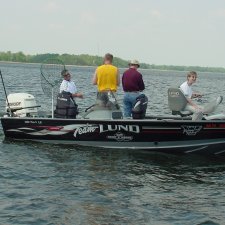
Walleyes are still active in the shallows. Warm weather has
lots of folks smiling.
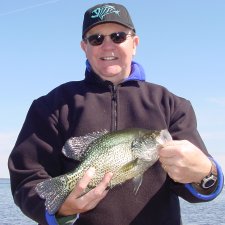
Warm surface temperatures are drawing Crappie, Bass and
Bluegill into the shallow water to spawn.


|
|
Fishing Report 5-22-06 Early Season Cold Water Fishing Calls For
Finesse |
|
The weather during the first full week of the open water Walleye
fishing season has been a challenge for Minnesota anglers. Surface
water temperatures hovering in the mid to low fifties are actually
losing ground as cold night temps dipping into the thirties coupled
with low daytime high temperatures and blustery North winds offer
little relief.
Walleye fishing for most folks has been much better during the warmer
afternoon hours and if you plan to visit the lake this week, I’d
suggest sleeping in and hitting the water around noon. While there
have been a couple of days where morning fishing was good, the
afternoon bite has held up to be as good or even better on most days.
Presentations are, as you’d expect, lightweight jigs of 1-16 or 1-8
ounce tipped with Shiners, Rainbow Chubs or nice Fatheads are
producing the best action. Live bait rigs with leeches or night
crawlers are working for some folks, but are a distant second in terms
of action. Jigging action is really important now, so it’s important
to vary your approach. At times, aggressive jigging, hopping or
snapping has turned fish on. At other times, we’ve found that a simple
steady wiggling or twitching of the rod tip triggered fish better. In
really shallow water where sand grass has been a problem, we’ve set a
slip bobber for about 18 inches off the bottom and used a slightly
heavier jig while drifting with reasonably good success.
Walleye location is still primarily shoreline structure like shallow
drop-offs, weedbeds and shallow rocks. There are also some schools of
fish to be found on the deeper water breakline in water depths of 22
to 30 feet adjacent to shoreline structures. These deeper fish are
trickier to trigger, but we’ve done all right with a 1-4 ounce jig
fished vertically. It’s been a good strategy to fish the shallows
first, then move out deeper to clean up some of these scattered
schools of deeper fish. If you’re fishing on some of the smaller,
deeper lakes try the outer edges of weed beds about two to four feet
deeper than the weedline. Aggressive Northern Pike are using the weed
cover and make Walleye fishing really tough. But the clean-lip areas
just before the drop off breaks into deeper water. These areas are
holding Walleye in fair numbers. You might find that there are several
small schools spread out along an extensive drop off, so be patient
and keep moving.
We’ve discovered some really aggressive Perch during the past few
days. Both size and numbers are very good! Key locations have been
shallow weeds, especially Cabbage in 5 to 8 feet of water. There are
some early insect hatches going on and the Perch we’re catching are
virtually full of these insect larvae. This is usually a pattern that
continues for a while, so it could be a great time to get the kids
packed up to gather the makings of a great fish fry.
Crappies are in the midst of their spawning run right now. Male
Crappie are sporting their Black spawning color and female Crappie are
plump with eggs. Cold nights force the fish out of the shallows, but
warm sunny afternoons trigger a move back in to the structures where
they’re doing the best they can to establish spawning beds. Pick and
choose your days and you’ll be able to get in on some action. The
predicted warming trend should help and I’d guess that Crappie action
will peak in the next week to 10 days, especially if the water temps
can reach back up into the lower 60 degree range. |
 |
|
 |
|
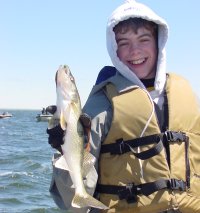
The 2006 Father & Son Walleye fishing trip at Bowen Lodge
was a big hit this year. Lots of wind and cold weather gave the group a
test. But the kids (and the dads) came through with flying colors and
bagged plenty of Walleye on Lake Winnie.
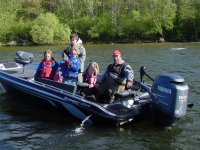
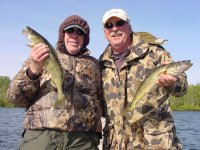
Cold weather hasn't stopped the Walleye fishing. Bundle up
and keep fishing until you find them.
|
|
Fishing Opener 2006 Red Lake
Walleyes, Great Family Fishing - Jeff Sundin |
|
The 2006 Walleye fishing
opener has finally arrived and for me, it was a once in a lifetime
experience. It's been 22 years since I actually fished with my own
wife on opening day, so using the re-opening of Red Lake and the
Mothers Day weekend as an excuse, I opted not to take a charter this
weekend. Instead we packed up the whole family including my mother and
headed to Washkish where we made a family event out of welcoming back
the Red Lake Walleyes. I doubt that it could have worked out any
better.
After a disappointing start,
sitting out the first half of the day hoping for a break from the
rain, we finally saw a little break on the radar screen and made a mad
dash for the lake in mid-afternoon. Our first pleasant surprises were
the terrific new boat ramps and expanded parking areas located on both
sides of the bridge. I talked with DNR officials who said that the
traffic was heavy, but below expectations and the available parking
had been sufficient to handle the fishing opener traffic throughout
the day. We found that getting on the water and finding a parking spot
was easy and within 20 minutes or so, we were on the water making
ready to fish.
We fished the area to the
Northwest of Washkish and concentrated mainly on the shallow breakline
from 4 to 7 feet of water. As expected, the Walleye were cooperative
and widely distributed. We found many loosely grouped packs of fish
and there were several stretches where action would start and stop as
we moved through the small schools. Even though we did locate several
better than average groups of fish, we opted to just keep on moving
along the break with the MinnKota rather than trying to stay with any
particular school of fish. These scattered groups of fish were really
a blessing because it split the crowd up into many small groups and
managing to fish around the traffic was very easy and pleasant.
We fished strictly with jigs &
minnows and used 1/16 and 1/8 ounce jigs tipped with shiners. For us,
colors weren't particularly important, but we did have one hot
fisher-girl who was using a 1/16 ounce bug eyed shorty in the
glow-pink combination and this particular color did work a bit better
than most others we tried. We also saw folks catching plenty fish
using slip bobbers as well and a few of them were picking up some
Crappies, but not in large numbers. We had expected a little more
Crappie action because of reports from friends earlier in the week,
but the dropping water temperature (51 degrees) from all of the recent
rain and cool weather must have temporarily sent the majority of those
fish back out into the main lake.
Coping with the protected slot
size of 17 to 26 inches for Walleye was no particular problem, but I
would estimate that we returned about 4 slot fish, for every keeper
size fish (under 17 inches). That said, we were still easily able to
each keep two fish for a fish fry and the Canadian style regulation
does have some potential to eventually become more widely accepted
among Minnesota anglers. There's no doubt that the DNR is serious
about enforcing the regulation though as we were greeted by DNR when
we arrived at the landing and again when we left. They were passing
out flyers explaining the regulations, taking creel assessment surveys
and checking anglers for licenses, safety gear and fish limits. If you
head up to Red Lake, have your ducks in a row and plan on getting
checked at least once, maybe more.
To me, this was a historic day
for Minnesota anglers and I think one has to give a lot of credit to
the folks who have helped bring about the recovery of the Walleye
fishery in this great lake. It's clear that the effort hasn't been
wasted and all in all the DNR, Red Lake Tribal Officials and
sportsmen's groups have worked pretty darn well together during this
process and the result is going to benefit everyone who has a stake in
seeing that the fishery continues to prosper. |
 |
|
 |
|
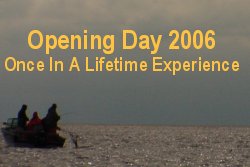
After an 8 year ban on Walleye fishing,
Red Lake is open again. Anglers who visited Red Lake on the 2006 opener
were rewarded with calm seas, light traffic and cooperating Walleyes.

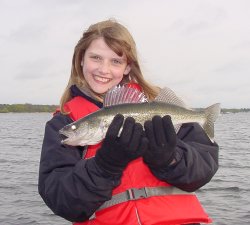
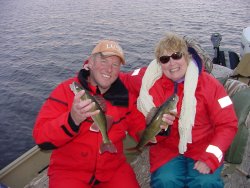
How can you beat a day like this with
the family?
|
|
